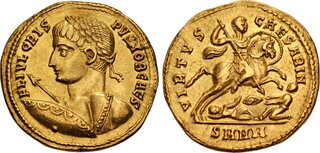| Classical Numismatic Group > Triton XXVII | Auction date: 9 January 2024 |
| Lot number: 911 Price realized: 15,000 USD (Approx. 13,739 EUR) Note: Prices do not include buyer's fees. | Show similar lots on CoinArchives Find similar lots in upcoming auctions on |
| Lot description: Crispus. Caesar, AD 316-326. AV Solidus (19.5mm, 4.52 g, 12h). Nicomedia mint. Struck AD 324-325. FL IVL CRIS PVS NOB CAES, laureate heroic bust left, wearing balteus, holding spear in right hand and shield in left / VIRTVS CAESARI N, Crispus on horseback riding right, holding shield in left hand, trampling and thrusting spear held in right hand at fallen enemy to right, kneeling left, both hands raised; beneath horse, another fallen enemy and shield; SMNM. RIC VII 84-5 var. (unlisted officina); Depeyrot 35/6; Biaggi 2068 var. (same). Lightly toned with some luster, light scratches and marks. Good VF. Very rare. Only three examples with the mint mark SMNM recorded by Depeyrot; two additional in CoinArchives. The eldest son of Constantine I, Flavius Julius Crispus inherited much of his father's charisma and military prowess. He was born circa AD 295-305 while Constantine was a junior officer in the court of the Emperor Diocletian. Apparently, Crispus was the only child born of Constantine's liaison with Minervina, probably his common-law wife. After his father became Caesar, Crispus could only watch as his mother was set aside so Constantine could marry Fausta, daughter of Diocletian's co-ruler Maximian, who soon produced three more sons and a daughter. In late AD 316, Constantine raised Crispus to the rank of Caesar and began grooming him for the succession. Crispus spent the next few years at Trier on the German frontier, honing his skills as a soldier and administrator. In the early 320s he oversaw campaigns against the Franks and Alemanni while Constantine was engaged with the Sarmatians to the East. Crispus further distinguished himself as his father's naval commander against Licinius in 324. He won a spectacular victory against the larger Licinian fleet at Byzantium, and later ferried his father's army from Thrace to Asia Minor to complete their triumph. Crispus was heaped with honors and seemed secure as Constantine's primary heir. In AD 326, he traveled to Italy to celebrate his father's 20th anniversary of rule. There, he apparently ran afoul of a plot hatched by his stepmother Fausta, who wanted to advance her own sons in the succession. In the summer of AD 326, Crispus was abruptly arrested at the town of Pola, charged with treason, and beheaded. Soon thereafter, Constantine ordered Fausta's execution via being smothered in her steam bath. He supposedly later ordered golden statue of Crispus be erected and dedicated "to the son I unjustly condemned." The events of AD 326 so embittered Constantine that he never returned to Italy, and they may have played a role in his decision to move the imperial capital to Byzantium, soon renamed Constantinople. This beautiful gold solidus depicts Crispus as a young hero, with his nude, muscular physique shown shouldering a shield and brandishing a spear. The reverse depicts him on horseback, making short work of Rome's babrarian enemies. The artistry fully reflects the return to Hellenistic styles in coinage evident in the Constantinian era. Estimate: 7500 USD |  |



